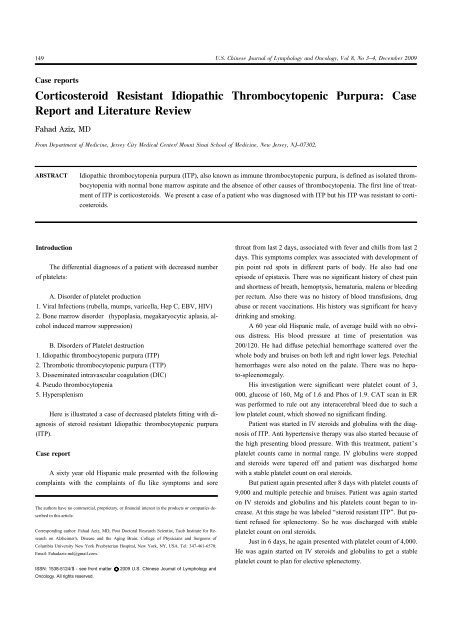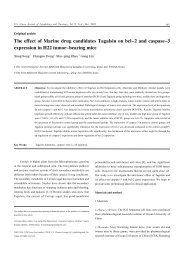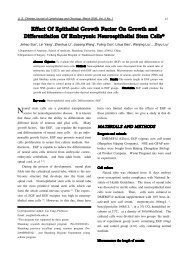Corticosteroid Resistant Idiopathic Thrombocytopenic Purpura ...
Corticosteroid Resistant Idiopathic Thrombocytopenic Purpura ...
Corticosteroid Resistant Idiopathic Thrombocytopenic Purpura ...
Create successful ePaper yourself
Turn your PDF publications into a flip-book with our unique Google optimized e-Paper software.
149<br />
U.S. Chinese Journal of Lymphology and Oncology, Vol 8, No 3-4, December 2009<br />
Case reports<br />
<strong>Corticosteroid</strong> <strong>Resistant</strong> <strong>Idiopathic</strong> <strong>Thrombocytopenic</strong> <strong>Purpura</strong>: Case<br />
Report and Literature Review<br />
Fahad Aziz, MD<br />
From Department of Medicine, Jersey City Medical Center/ Mount Sinai School of Medicine, New Jersey, NJ-07302.<br />
ABSTRACT<br />
<strong>Idiopathic</strong> thrombocytopenia purpura (ITP), also known as immune thrombocytopenic purpura, is defined as isolated thrombocytopenia<br />
with normal bone marrow aspirate and the absence of other causes of thrombocytopenia. The first line of treatment<br />
of ITP is corticosteroids. We present a case of a patient who was diagnosed with ITP but his ITP was resistant to corticosteroids.<br />
Introduction<br />
The differential diagnoses of a patient with decreased number<br />
of platelets:<br />
A. Disorder of platelet production<br />
1. Viral Infections (rubella, mumps, varicella, Hep C, EBV, HIV)<br />
2. Bone marrow disorder (hypoplasia, megakaryocytic aplasia, alcohol<br />
induced marrow suppression)<br />
B. Disorders of Platelet destruction<br />
1. <strong>Idiopathic</strong> thrombocytopenic purpura (ITP)<br />
2. Thrombotic thrombocytopenic purpura (TTP)<br />
3. Disseminated intravascular coagulation (DIC)<br />
4. Pseudo thrombocytopenia<br />
5. Hypersplenism<br />
Here is illustrated a case of decreased platelets fitting with diagnosis<br />
of steroid resistant <strong>Idiopathic</strong> thrombocytopenic purpura<br />
(ITP).<br />
Case report<br />
A sixty year old Hispanic male presented with the following<br />
complaints with the complaints of flu like symptoms and sore<br />
The authors have no commercial, proprietary, or financial interest in the products or companies describedinthisarticle.<br />
Corresponding author: Fahad Aziz, MD, Post Doctoral Research Scientist, Taub Institute for Research<br />
on Alzheimer's, Disease and the Aging Brain, College of Physicians and Surgeons of<br />
Columbia University New York Presbyterian Hospital, New York, NY, USA. Tel: 347-461-6570;<br />
Email: Fahadaziz.md@gmail.com.<br />
ISSN: 1538-5124/$ - see front matter<br />
Oncology. All rights reserved.<br />
2009 U.S. Chinese Journal of Lymphology and<br />
throat from last 2 days, associated with fever and chills from last 2<br />
days. This symptoms complex was associated with development of<br />
pin point red spots in different parts of body. He also had one<br />
episode of epistaxis. There was no significant history of chest pain<br />
and shortness of breath, hemoptysis, hematuria, malena or bleeding<br />
per rectum. Also there was no history of blood transfusions, drug<br />
abuse or recent vaccinations. His history was significant for heavy<br />
drinking and smoking.<br />
A 60 year old Hispanic male, of average build with no obvious<br />
distress. His blood pressure at time of presentation was<br />
200/120. He had diffuse petechial hemorrhage scattered over the<br />
whole body and bruises on both left and right lower legs. Petechial<br />
hemorrhages were also noted on the palate. There was no hepato-spleenomegaly.<br />
His investigation were significant were platelet count of 3,<br />
000, glucose of 160, Mg of 1.6 and Phos of 1.9. CAT scan in ER<br />
was performed to rule out any interacerebral bleed due to such a<br />
low platelet count, which showed no significant finding.<br />
Patient was started in IV steroids and globulins with the diagnosis<br />
of ITP. Anti hypertensive therapy was also started because of<br />
the high presenting blood pressure. With this treatment, patient 爷 s<br />
platelet counts came in normal range. IV globulins were stopped<br />
and steroids were tapered off and patient was discharged home<br />
with a stable platelet count on oral steroids.<br />
But patient again presented after 8 days with platelet counts of<br />
9,000 and multiple petechie and bruises. Patient was again started<br />
on IV steroids and globulins and his platelets count began to increase.<br />
At this stage he was labeled 野 steroid resistant ITP 冶 .Butpatient<br />
refused for splenectomy. So he was discharged with stable<br />
platelet count on oral steroids.<br />
Just in 6 days, he again presented with platelet count of 4,000.<br />
He was again started on IV steroids and globulins to get a stable<br />
platelet count to plan for elective splenectomy.
Aziz. <strong>Corticosteroid</strong> <strong>Resistant</strong> <strong>Idiopathic</strong> <strong>Thrombocytopenic</strong> <strong>Purpura</strong><br />
150<br />
Discussion<br />
In 1997, American Society of Hematology (ASH) described<br />
two criteria 爷 s for the diagnosis of ITP;<br />
1. Isolated thrombocytopenia with otherwise normal CBC and peripheral<br />
smear.<br />
2. No other condition or factors that may cause thrombocytopenia.<br />
ITP is usually divided into two types,<br />
1. Acute ITP<br />
2. Chronic ITP<br />
Acute ITP<br />
- More Prevalent in Late<br />
Spring to Winter<br />
-Prevalent among children<br />
6 months<br />
-No seasonal predilection<br />
-More prevalent in adolescents and<br />
adults<br />
-3:1 Female to Male<br />
-More likely to have underlying autoimmune<br />
disease<br />
Fig.1 Petechie on legs<br />
Fig.2 Bruises and petechie on leg<br />
Fig.3 Petechial hemorrhages on the palate<br />
Fig.4 Muco-cutaneous bleeding<br />
Fig.5 Peripheral smear showing megathrombocytes<br />
Fig.6 Bone marrow aspirate showing megakaryocytes in the ab 鄄<br />
sence of any other abnormality.
151<br />
U.S. Chinese Journal of Lymphology and Oncology, Vol 8, No 3-4, December 2009<br />
ITP is often diagnosed on the basis of routine labs, if thrombocytopenia<br />
is mild. Most commonly, patients of ITP usually present<br />
with muco-cutaneous bleeding (oral ulcers, epistaxis), menorrhagia,<br />
pupura; which is non-palpable, painless and localized to dependent<br />
areas.<br />
Less commonly, ITP patients may present as GI bleeding,<br />
hematuria, intracranial hemorrhage and hemarthrosis.<br />
Splenomegaly, if present, always suggests an alternate diagnosis.<br />
Laboratory diagnosis<br />
ITP is basically diagnosis of exclusion. On complete blood<br />
count, the hall mark of ITP is the isolated thrombocytopenia. On<br />
peripheral blood smear, red blood cells and leukocytes are normal.<br />
The morphology of platelets is typically normal, with varying numbers<br />
of large platelets. Some patients with acute ITP may have<br />
megathrombocytes or stress platelets, reflecting the early release of<br />
megakaryocytic fragments in to circulation.<br />
Assays for platelet antigen-specific antibodies, platelet-associated<br />
immunoglobulin, or other platelet antibodies are available in<br />
some medical centers. These tests are usually not recommended by<br />
American Society of Hematology because of poor positive/negative<br />
predictive values. Testing of anti-platelet antibodies is not required<br />
to diagnose ITP (1).<br />
Computed tomography (CT) scanning and magnetic resonance<br />
imaging (MRI) are relatively benign and useful non-invasive<br />
imaging studies that can be used to rule out other causes of thrombocytopenia.<br />
The primary diagnostic evaluation is bone marrow aspiration<br />
and biopsy. Patients with ITP have normal-to-increased number of<br />
megakaryocytes in the absence of other significant abnormalities.<br />
The cellularity of the aspirate and the morphology of erythroid and<br />
myeloid precursors should be normal (2).<br />
Management<br />
Major Bleedings are rare if the platelet counts are more than<br />
10,000. Treatment goal for ITP is to get safe platelet levels and<br />
prevent bleeding.<br />
American Society of Hematology gives the following guidelines<br />
for the treatment of ITP,<br />
1. Don 爷 ttreatif,<br />
Platelet count > 50,000 and patient is asymptomatic.<br />
2. Consider treatment if;<br />
Platelet count > 50,000 and there is mucous membrane bleeding.<br />
3. Definitely treat if;<br />
Platelet count < 50,000<br />
4. Hospitalize if;<br />
There is severe bleeding regardless of platelet count or platelet<br />
count < 20,000 and mucous membrane are bleeding.<br />
<strong>Corticosteroid</strong>s i.e. oral prednisone, IV methylprednisolone or<br />
high-dose dexamethasone is the drug of choice for the initial management<br />
of ITP. It 爷 s important to get the bone marrow biopsy to<br />
confirm the clinical presentation, because corti costeroids may<br />
change marrow morphology (3, 4, and 5).<br />
IV immunoglobulin (IVIG) has been the drug of second<br />
choice. For Rh (D)-positive patients with ITP and intact spleens,<br />
IV Rho immunoglobulin (RHIG) offers comparable efficacy, less<br />
toxicity, greater ease of administration and a lower cast (6, 7).<br />
In patients with acute ITP, splenectomy usually results in<br />
rapid, complete and life-long clinical remission. In patients with<br />
chronic ITP, the results of splenectomy are less predictable.<br />
Refractory ITP<br />
Refractory ITP is defined as platelet count






